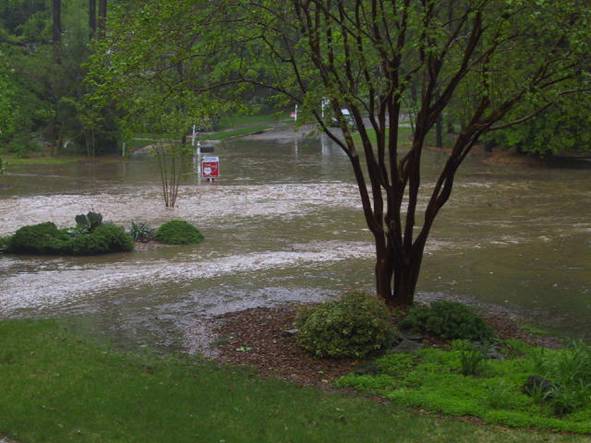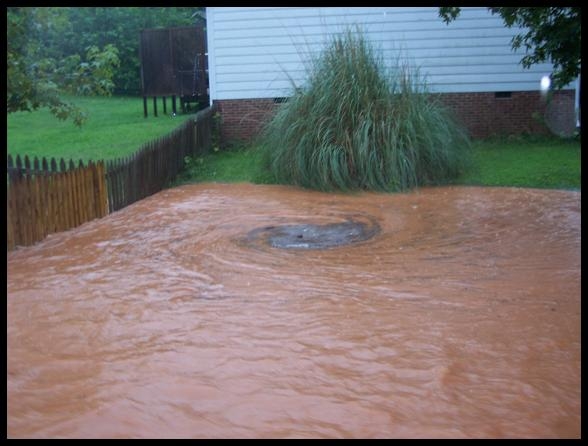When it rains, it pours.
And when it rains in Raleigh, all too often, it floods.

City of Raleigh
Roadway overtopping of Grist Mill Road.
For the first 209 years of its existence, the City did very little to regulate the stormwater runoff problems caused by the influx of new residential and commercial developments.
That all changed 16 years ago.
“In 2001, we adopted a pretty stringent pallet of regulations,” said Benjamin Brown, Raleigh’s Stormwater Development Manager.
“They were more for larger sites and larger developments, because that’s what we were really seeing back then: large subdivisions, large buildings, larger lot sizes.”
But times have changed, and with them, so have the City’s stormwater management regulations.
“There were exemptions built into that code for smaller residential lots and smaller residential subdivisions, but we’re seeing a definite shift in development trends toward redeveloping smaller residential lots,” Brown said.
Although these smaller projects were not having as significant an impact as the larger developments of the late 1990s, Brown said they were beginning to affect the neighbors of these new-home builders.
After a “decent amount of concerned citizens” contacted City Council about the problems they were facing, Council in November 2016 adopted a text change that put in place new stormwater regulation standards for smaller sites that had been exempted from the 2001 regulations.
“It wasn’t across the board flooding,” Brown said of the problems caused by the redevelopment of smaller residential lots, but rather, a myriad runoff issues such as erosion that sprung up when older homes were torn down and replaced with newer, larger structures.
“When people are building new houses, more impervious — any hardened surface, a driveway, a sidewalk — more impervious is being added,” Brown said.
“And that runoff was impacting adjacent property owners.”

City of Raleigh
Fortunately, not all problems caused by small-site development are this drastic
More generally, impervious surface area is any material that prevents the natural absorption of water into the soil. A home’s roof, for example, is considered an impervious surface, whereas an inground pool is not.
There are some gray areas: slatted decks, for example, are considered 100 percent impervious under North Carolina State law, but in Raleigh, slatted decks built over a standard lawn are classified as 50 percent impervious. Brown said this is due to the City working with the Environmental Protection Agency on its stormwater regulation program, which supersedes state law.
The November text change adopted by Council now requires these smaller residential projects to adhere to existing impervious surface limitations for their zoning district. The less dense the zoning district, the stricter the limitations: for properties in Residential-1 districts, the maximum impervious surface area is 20 percent. In Residential-10, it’s 65 percent.
All those developing projects subject to these new regulations are required to obtain a $194 $82 stormwater tracking permit and submit an as-built impervious survey before final inspection.
Editor’s note: Since the initial publication of this article, there has “been an update to the permit cost associated with stormwater requirements for smaller site development,” according to Kristin Freeman, a Communications Specialist in the City’s Engineering Services Department.
“The cost for the stormwater tracking permit has been reduced from $194 to $82 in order to make the permit more affordable and the permitting process more seamless,” said Freeman.
For those wishing to exceed the maximum allowed impervious surface area — as of January 11, Brown said, none had — two options are available.
First up is a $1,175, 30-day stormwater analysis that would need to show the development would not cause a more than roughly half an inch rise in flood levels for two, 10, 25, 50, and 100-year storm events.
Builders could also choose to install a stormwater control device that would “capture the difference in volume between the proposed post-development and the maximum impervious limit (or existing condition, whichever is greater) for the 90th percentile storm (1.4 inches of rainfall in a 24-hour period).”
However, for projects on residential lots with an existing home that is not being torn down, Council put in place an exemption that would allow homeowners to exceed the impervious limitation by 400 square feet.
“Someone keeping their house but adding a patio, they’d be able to do a smaller-impact project,” Brown said.
The new policies, still in their infancy, have so far generated more curiosity than criticism, Brown said, adding that there had been many inquiries into the program’s specifics. Fortunately, the City has put together a helpful FAQ, which can be accessed here.
“We think these new regulations will solve a lot of problems — I can’t say they will solve every problem, that’s just not something I can promise,” Brown said, laughing.

City of Raleigh
Fortunately, not all problems caused by small-site development are this drastic
Related: City’s Stormwater Quality Cost Share Program Underutilized.